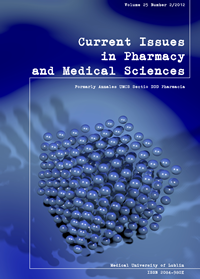Dissolution of lithium carbonate from three types extended-release capsules in paddle, basket and flow-through apparatus
DOI:
https://doi.org/10.12923/j.2084-980X/25.2/a.11Słowa kluczowe:
dissolution test, pellets, minitablets, lithium carbonate, extended-release capsulesAbstrakt
Three types of 24-h extended-release multiparticulate capsules containing a dose of 480-504 mg lithium carbonate in a form of either pellets or 2 mm minitablets or 6 mm tablets were prepared. Dissolutions tests were performed using three different pharmacopoeial apparatus: basket, paddle and flow-through apparatus. Only capsules filled with pellets showed the same dissolution profiles, irrespective of the apparatus used in the study. In the case of two other formulations, the slowest dissolution occurred in the flow-through apparatus. The largest difference between release profiles from different apparatus was observed for the capsule filled with 6 mm tablets. The observations may indicate that probability of good reproducibility of dissolution profiles obtained in different test conditions, including change of apparatus, is related to either size or a number of the units in a capsule.
Bibliografia
1. Crison JR: Developing dissolution tests for modified release dosage forms: General considerations. Dissol. Technol., 6/2, 5, 1999.
2. EMEA Note for Guidance on Quality of Modified Release Products (2000). Committee for Proprietary Medicinal Products. London: EMEA.
3. FDA Guidance for Industry. Extended release oral dosage forms: Development, evaluation and application of in vitro / in vivo correlations (1997). Food and Drug Administration Center for Drug Evaluation and Research (CDER).
4. Fotaki N: Flow-through cell apparatus (USP apparatus 4): operation and features. Dissol. Technol., 46, Nov 2011.
5. Jantratid E et al.: Application of biorelevant dissolution tests to the prediction of in vivo performance of diclofenac sodium from an oral modified-release pellet dosage form. Eur. J. Pharm. Sci., 37, 434, 2009.
6. Jones BE (2004). Capsule standards. In: Pharmaceutical Capsules. Podcheck F, Jones BE (editors). London: Pharmaceutical Press; p. 239.
7. Kortejarvi H et al.: Development of level A, B and C in vitro-in vivo correlations for modified-release levosimendan capsules. Int. J. Pharm., 241, 87, 2002.
8. Meyer MC et al.: The effect of gelatin cross-linking on the bioequivalence of hard and soft gelatin capsules. Pharm. Res., 17, 962, 2000.
9. Pietkiewicz P et al.: Lithium carbonate 24-h extended-release capsule filled with 6 mm tablets. Boll. Chim. Farm., 142, 69, 2003.
10. Vervaet C, Baert L, Remon JP: Extrusion-spheronization. A literature review. Int. J. Pharm., 116, 131, 1995.
11. Webb AL, Solomon DA, Ryan CE: Lithium levels and toxicity among hospitalized patients. Psychiatr. Serv., 52, 229, 2001.
12. Zahirul M, Khan I: Dissolution testing for sustained or controlled release oral dosage forms and correlation with in vivo data: challenges and opportunities. Int. J. Pharm., 140, 131, 1996.
Pobrania
Opublikowane
Numer
Dział
Licencja
Prawa autorskie (c) 2012 Autorzy

Praca jest udostępniana na licencji Creative Commons Attribution-NonCommercial-NoDerivatives 3.0 Unported License.


